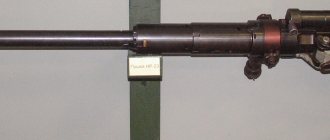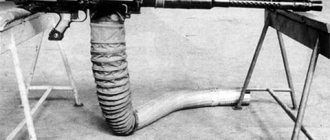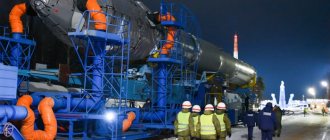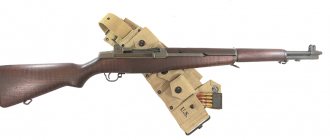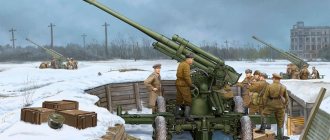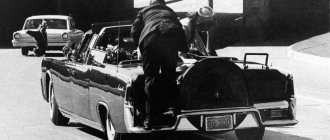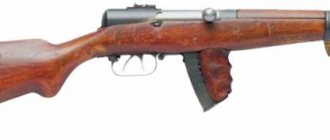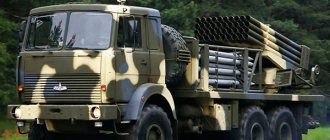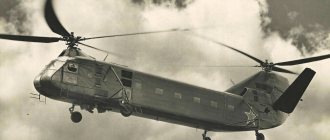| ZSU-37 | |
| Combat weight, t | 10,5—12,2 |
| Crew, people | 4 |
| Story | |
| Years of production | 1944—1946 |
| Number of issued, pcs. | 75+ |
| Dimensions | |
| Case length, mm | 4900 |
| Case width, mm | 2700 |
| Height, mm | 2080 |
| Ground clearance, mm | 315 |
| Booking | |
| Armor type | homogeneous rolled high hardness |
| Body forehead (top), mm/deg. | 35 / 60° |
| Body forehead (bottom), mm/deg. | 45 / −30° and 15 / −81° |
| Hull side (top), mm/deg. | 15 / 0° |
| Hull side (bottom), mm/deg. | 15 / 0° |
| Hull stern (top), mm/deg. | 15 / 76° |
| Hull rear (bottom), mm/deg. | 25 / −44° |
| Bottom, mm | 10 and 6 |
| Housing roof, mm | 10 |
| Armament | |
| Caliber and brand of gun | 37 mm 61-K mod. 1939 |
| Barrel length, calibers | 62,6 |
| Gun ammunition | 320 |
| Mobility | |
| engine's type | carburetor, 6‑cylinder (2 pcs.) |
| Engine power, l. With. | 2×70 |
| Highway speed, km/h | 42 |
| Speed over rough terrain, km/h | 20—25 |
| Cruising range on the highway, km | 330 |
| Suspension type | torsion bar individual |
| Ditch to be overcome, m | 1,7 |
| Fordability, m | 1,0 |
ZSU-37
- a light-weight Soviet self-propelled artillery unit (SAU), belonging to the class of anti-aircraft self-propelled units. Cars of this brand have been mass-produced at the Mytishchi Machine-Building and Gorky Automobile Plants since 1944. Before the end of World War II, 75 self-propelled guns were built. The basis for the ZSU-37 was the light anti-tank self-propelled gun SU-76M. Production of the ZSU-37 continued in the post-war period, even after the base SU-76M was discontinued.
The ZSU-37 was the first production Soviet armored self-propelled anti-aircraft gun on a tracked chassis, ideal for protecting mobile units from air attacks. The main weapon of the vehicle was a 37-mm 61-K anti-aircraft gun mounted in a turret with circular rotation. The self-propelled gun was also equipped with a range finder and radio station.
In computer games
| : Incorrect or missing image | This section is missing references to information sources. Information must be verifiable, otherwise it may be questioned and deleted. You may edit this article to include links to authoritative sources. This mark is set February 28, 2016 . |
K: Wikipedia: Articles without sources (type: not specified)
Since the ZSU-37 did not take part in real battles of World War II, it can rarely be seen in computer games.
ZSU-37 can be seen in the following computer games:
- in the domestic “IL-2 Sturmovik”;
- in the domestic RTS “Sudden Strike: The Last Stand”;
- in the domestic RTS “Blitzkrieg II”;
- in the domestic RTS “Behind Enemy Lines 2: Brothers in Arms”;
- in the domestic RTS “Behind Enemy Lines 2: Desert Fox”;
- in the domestic RTS “Behind Enemy Lines 2: Assault”;
- in the German RTS “War Front: Turning Point”;
- in the French RTS "RUSE";
- in the domestic “War Thunder”.
It is worth noting that the reflection of the tactical and technical characteristics of armored vehicles and the features of their use in battle in many computer games is far from reality.
Specifications
Below are the performance characteristics of the ZSU-23-4 “Shilka”.
| Year of adoption | 1962 |
| Dimensions of the affected area, km: | |
| – by range | 0-2,5 |
| – in height | 0-1,5-2 |
| Speed of targets hit, m/s: | |
| - when shooting towards | 450 |
| - when shooting in pursuit | 300 |
| Number and caliber of guns, mm | 4X23 |
| Projectile weight, kg | 0,19 |
| Initial projectile speed, m/s | 1000 |
| Possibility of shooting on the move | Yes |
| All-weather operation | Yes |
| Weight, t | 20,5 |
| Calculation, pers. | 4 |
Links
Medium tanks T-34 T-34-57 A-43/T-34M ·
A-44
·
KV-13
·
T-43
· T-34-85 · T-44 ·
T-34-100Heavy tanks KV-1 · KV-2 · T-150 ·
KV-220
·
KV-3
·
KV-4
· KV-1s ·
KV-5
·
KV-1K
· KV-85 ·
KV-9
·
KV-100
·
KV-122
·
EKV
· IS-1 · IS-2 ·
Object 244
·
Object 245
·
Object 248
· IS-3 ·
ST-1
·
IS-5
·
IS-6Flamethrower and chemical tanks KV-6 · KV-8 · OT-34 ·
KV-12Surrogate tanks NI-1 · Light self-propelled guns ZIS-41 ·
76.2 mm assault support gun
·
I13.73-SU
·
I13.75-SU
·
I13.76-SU
· SU-76 ·
SU-71
·
SU-15
·
SU-16
·
SU-IT-45
·
SU-74A
·
SU-74B
·
SU-74D
·
GAZ-75
·
NATI-TSAKB
·
Tank destroyer (MVTU project)
·
SU-85A
·
KSP-76
·
OSU-76
·
SU-85BMedium self-propelled guns U-34 · SG-122 · SU-122 ·
SU-D25
SU-122М
·
SU-85-I
· SU-85 ·
SU-122-III
·
SU-85-IV
· SU-76i ·
SU-D15
·
SU-85BM -I/SU-85BM-II
· SU-100 ·
SU-122P
·
SU-122-44
·
ESU-100
·
SU-100M-1
·
SU-100M-2
·
SU-101 · SU-102Heavy self-propelled guns KV-7 ·
U-18
·
U-19
· SU-152 ·
S-51
·
S-59
· ISU-152 · ISU-122 · ISU-122S ·
ISU-152-1
ISU-152-2
· -
122-1
·
ISU-122-3
·
ISU-130
·
ISU-152 model 1945Surrogate self-propelled guns ZIS-30 · HTZ-16 ZSU ZIS-43 ·
T-90
·
SU-72
·
SU-11
·
ZSU-37MLRS BM-8-24 BM-13-16 BM-8–48 BM-13N BM-31-12 Armored cars LB-62 · · BA-64
Armored personnel carriers TB-42 ·
BA-64E
·
B-3Armored tractors Object 42 ·
ZIS-22MB
·
ATP-1Combat snowmobiles and snowmobiles TsAGI-AHT-IV · NKL-16 · 02SS · NKL-26 · RF-8 (GAZ-98) ·
BA-64-ZTorpedo wedges ET-1-627 italics experimental samples and those that did not go into mass production were identified
Description of design
ZSU-23-4 "Shilka" has a welded body with bulletproof and anti-fragmentation armor. It is divided into three compartments: control, located in the front of the vehicle, the fighting compartment, located in its center, and the power compartment, in the rear. On the right side of the anti-aircraft gun there are three hatches, through which the equipment of the machine is dismantled and serviced, as well as the ventilation of the units.
The Shilki turret is equipped with a quadruple 23-mm AZP-23 Amur gun, the automation of which operates by removing powder gases from the barrel. Each barrel is equipped with a cooling system casing and a flash suppressor. The cartridge feed is lateral, from a belt link with the cartridge skewed. The tapes are in cartridge boxes. The turret contains two boxes; the system for cocking anti-aircraft guns is pneumatic.
The Shilka ammunition consists of two types of 23-mm shells: armor-piercing BZT and fragmentation OFZT. Armor-piercing BZT ammunition does not have an explosive and contains only an incendiary composition for tracing. OFZT shells have a fuse and a self-destructive device (action time is 5-10 seconds). In a belt for four rounds of OFZT there is one BZT.
Guidance is carried out using hydraulic drives, manual guidance is also possible. The rate of fire is 3400 rounds per minute.
In the instrument compartment of the tower there is a radar-instrument complex, with the help of which the target is searched, tracked, and projectile trajectories and the necessary lead are calculated. The detection range of airborne objects is 18 km.
The Shilka anti-aircraft complex can fire at air targets in several modes:
- in automatic;
- in semi-automatic;
- along foreshortening rings;
- according to remembered coordinates;
- against ground targets.
Automatic firing mode is considered the main one.
The radar-instrument complex consists of the following elements:
- lamp radar 1RL33M2;
- analog counting and solving device;
- sighting device;
- stabilization systems.
The combat vehicle is equipped with an R-123M radio station and a TPU-4 intercom.
ZSU-23-4 "Shilka" is equipped with a V6R diesel engine. It has six cylinders, liquid cooling and a maximum power of 206 kW. The vehicle has two aluminum fuel tanks with a total volume of 515 liters. This was enough for up to 400 km. The additional installation is intended to power the on-board electronics.
The chassis of the machine consists of two drive wheels, two guide wheels and twelve road wheels with rubber-coated rims. Suspension – independent torsion bar.
The crew is protected from weapons of mass destruction by creating excess pressure in the fighting compartment and purifying the air.
The modernization of the Shilka anti-aircraft complex followed the path of improving its ability to detect air targets, as well as increasing the security of the complex. Back in the mid-70s, the Ovod-M-SV complex was created to control the fire of anti-aircraft guns at the regimental level. It included the Luk-23 radar and an automated fire control system.
In the mid-90s, modifications “Shilka-M4” and “Shilka-M5” appeared with more advanced fire control systems. To destroy armored targets, a 23-mm sub-caliber ammunition was created.
In 1999, the Shilka modification was presented to the general public, the turret of which was additionally equipped with Igla MANPADS.
An excerpt characterizing the ZSU-37
On a piece of paper he wrote down what was needed in Smolensk, and he, walking around the room past Alpatych, who was waiting at the door, began to give orders. - First, postal paper, do you hear, eight hundred, according to the sample; gold-edged... a sample, so that it will certainly be according to it; varnish, sealing wax - according to a note from Mikhail Ivanovich. He walked around the room and looked at the memo. “Then personally give the governor a letter about the recording. Then they needed bolts for the doors of the new building, certainly of the style that the prince himself had invented. Then a binding box had to be ordered for storing the will. Giving orders to Alpatych lasted more than two hours. The prince still did not let him go. He sat down, thought and, closing his eyes, dozed off. Alpatych stirred. - Well, go, go; If you need anything, I will send it. Alpatych left. The prince went back to the bureau, looked into it, touched his papers with his hand, locked it again and sat down at the table to write a letter to the governor. It was already late when he stood up, sealing the letter. He wanted to sleep, but he knew that he would not fall asleep and that his worst thoughts came to him in bed. He called Tikhon and went with him through the rooms to tell him where to make his bed that night. He walked around, trying on every corner. Everywhere he felt bad, but the worst thing was the familiar sofa in the office. This sofa was scary to him, probably because of the heavy thoughts that he changed his mind while lying on it. Nowhere was good, but the best place of all was the corner in the sofa behind the piano: he had never slept here before. Tikhon brought the bed with the waiter and began to set it up. - Not like that, not like that! - the prince shouted and moved it a quarter away from the corner, and then again closer. “Well, I’ve finally done everything over, now I’ll rest,” the prince thought and allowed Tikhon to undress himself. Frowning in annoyance from the efforts that had to be made to take off his caftan and trousers, the prince undressed, sank heavily onto the bed and seemed to be lost in thought, looking contemptuously at his yellow, withered legs. He didn’t think, but he hesitated in front of the difficulty ahead of him to lift those legs and move on the bed. “Oh, how hard it is! Oh, if only this work would end quickly, quickly, and you would let me go! - he thought. He pursed his lips and made this effort for the twentieth time and lay down. But as soon as he lay down, suddenly the whole bed moved evenly under him back and forth, as if breathing heavily and pushing. This happened to him almost every night. He opened his eyes that had closed. - No peace, damned ones! - he growled with anger at someone. “Yes, yes, there was something else important, I saved something very important for myself in bed at night. Valves? No, that's what he said. No, there was something in the living room. Princess Marya was lying about something. Desalle—that fool—was saying something. There’s something in my pocket, I don’t remember.” - Quiet! What did they talk about at dinner? - About the prince, Mikhail... - Shut up, shut up. “The prince slammed his hand on the table. - Yes! I know, a letter from Prince Andrei. Princess Marya was reading. Desalles said something about Vitebsk. Now I'll read it. He ordered the letter to be taken out of his pocket and a table with lemonade and a whitish candle to be moved to the bed, and, putting on his glasses, he began to read. Here only in the silence of the night, in the faint light from under the green cap, did he read the letter for the first time and for a moment understand its meaning. “The French are in Vitebsk, after four crossings they can be at Smolensk; maybe they’re already there.” - Quiet! - Tikhon jumped up. - No, no, no, no! - he shouted.
Combat use
- War of attrition - on the side of Egypt
- The Vietnam War - on the side of North Vietnam
- Arab-Israeli War - both sides
- Battles for Mount Hermon - on the side of Syria
- First Angolan Civil War – Angolan side
- Egyptian-Libyan war - on the side of Libya
- Ethiopian-Somali war - on the side of Somalia
- Afghan war
- Iran-Iraq War – on the side of Iraq
- Civil war in Lebanon - on the side of Syria
- They were used to protect against US aircraft attacks on Libya in the spring of 1986.
- Gulf War – on the side of Iraq
- Armed conflict in Transnistria – both sides
- The Karabakh conflict is on the side of Armenia
- First Chechen War – both sides
- NATO operation against Serbia is on the side of Yugoslavia
- Second Chechen War – both sides
- Iraq War – on the Iraqi side
- The civil war in Syria is on the Syrian side.
Fragment-resistant aircraft
When adopting the Shilka, the military and representatives of the military-industrial complex understood that the 23-mm Amur cannon was too weak. This applied to the short slanted firing range, to the ceiling, and to the weakness of the high-explosive effect of the projectile. The Americans added fuel to the fire by advertising the new A-10 attack aircraft, supposedly invulnerable to 23-mm Shilka shells. As a result, almost immediately after the Shilka was adopted into service, the army began talking about modernization in terms of increasing firepower and, first of all, increasing the effective firing range and destructive effect of the projectile.
Since the fall of 1962, several preliminary designs for installing 30-mm machine guns on the Shilka have been worked out. Among them, we considered the 30-mm revolver-type assault rifle NN-30 designed by OKB-16, used in the shipborne AK-230 installation, the 30-mm six-barrel assault rifle AO-18 from the shipborne installation AK-630, and the 30-mm double-barreled assault rifle AO-17 designed by KBP . In addition, the AO-16 57-mm double-barreled assault rifle, specially designed at the KBP for the ZSU, was tested.
The upper part of the modernized ZSU-23−4M5 Shilka anti-aircraft gun with a launcher for eight Igla anti-aircraft homing missiles.
On March 26, 1963, at a technical council in Mytishchi near Moscow, it was decided to increase the caliber of the ZSU from 23 to 30 mm. This doubled (from 1000 to 2000 m) the zone of 50% probability of hitting a target and increased the firing range from 2500 to 4000 m. Firing efficiency against a MiG-17 fighter flying at an altitude of 1000 m at a speed of 200-250 m/s , increased by 1.5 times. The obstacle was the hole for extracting the cartridges!
For the 30-mm NN-30 assault rifles, which were planned to be installed on the new Shilka, the cartridges are thrown back and down, while the removal of cartridges from the Shilka turret is forward and sideways. Eliminating this seemingly insignificant drawback would require such significant alterations in the Shilka design that it turned out to be easier to build a new ZSU, which later received the name “Tunguska” and was put into service in 1982.
Modifications
Object 510
Based on the order of the Ministry of Transport Engineering No. 0013 of February 8, 1956, the design bureau of plant No. 174, together with plant No. 342, developed a modification of the ZSU-57-2, equipped with individual watercraft. The project manager was A.E. Sulin. The car was assigned the index “Object 510”.
In 1956, two prototypes were manufactured and passed state tests. In 1961, the Object 510 was put into service. A total of 6 production vehicles were produced.
“Object 510” differed from the basic version by installing a device for hanging steel pontoons. The pontoons were intended for crossing water obstacles both under their own power and in tow.
The weight of the vehicle with pontoons was 37.8 tons. Buoyancy reserve - 40%. When moving on water, two propellers were used. Movement on water was allowed with waves up to 5 points. The width of the water barrier, overcome independently, was 50-60 km. The maximum speed afloat was 12 km/h. The maximum speed when towing is no more than 15 km/h.
In addition, when the sea state was up to 2 points, shooting at anti-aircraft targets was ensured. It was also possible to transport troops on a boat of up to 40 people, but shooting was prohibited.
Object 520
By the end of the 1950s, due to the development of jet aviation, maximum speeds increased to 1000-1200 km/h, and maneuverability increased. Therefore, to effectively counter such targets, automated aiming drives in combination with radar systems were needed.
In accordance with the resolution of the Council of Ministers of the USSR No. F416-211 dated April 17, 1957, the ZSU-57-2 was modernized in the design bureau of Plant No. 174. The modernization consisted of installing 57-mm SV-68 "Berezina" cannons and small-sized radio-optical instrument systems for autonomous fire control "Desna". G.V. Mazepa was appointed project manager, and the project received the index “Object 520”.
In 1959, 6 vehicles were manufactured that passed the PSI, but the Object 520 self-propelled gun was not accepted for service.
Combat use
ZSU-57-2 were sent to arm anti-aircraft artillery batteries of two-platoon tank regiments, 2 units per platoon (4 units in total). Due to the small volume of production, some of the batteries were equipped with ZTPU-2 installations on the chassis of the BTR-40 and BTR-152 armored personnel carriers instead of the ZSU-57-2.
The combat effectiveness of the ZSU-57-2 depended on the qualifications of the crew, the training of the platoon commander, and was due to the absence of a radar in the guidance system. Effective lethal fire could only be fired from a stop; firing “on the move” at air targets was not provided. The comparative firing efficiency of the ZSU-57-2 was lower than that of the S-60 gun batteries, since the latter had PUAZO-6 with SON-9, and later the RPK-1 Vaza radar instrument system. The effectiveness of using the ZSU-57-2 was higher due to its constant readiness to open fire, self-propelled mode, and the presence of armor protection for the crew.
ZSU-57-2 were used in the Vietnam War, in the conflicts between Israel and Syria and Egypt in and 1973, as well as in the Iran-Iraq War. Due to the relatively low rate of fire and the lack of automated radar guidance devices, this vehicle was not very effective.
In April 2014, video footage of the use of ZSU-57-2 by the Syrian army in battles in the vicinity of Damascus appeared.
Combat effectiveness
In addition to the listed factors (low rate of fire and lack of automated radar guidance devices), to assess the effectiveness of the installation, it is necessary to take into account the following: In the period 1950-1957 (the period of the creation of the ZSU-57-2), foreign armies did not have the best ZSU. The US Army had the M19 ZSU on the chassis of the M24 Chaffee light tank, developed in 1945, and the M42 on the chassis of the M41 light tank, which entered service with the troops since 1954. Armament: twin 40mm Bofors cannon. The British Armed Forces had a self-propelled gun based on the Crusader tank, created in 1943, armed with a single-barrel 40 mm Bofors L60 cannon. All these installations were available in small quantities, especially in comparison with the number of front-line aviation of the USSR Air Force. The 40-mm Bofors L60 cannon had a rate of fire of 120 rounds/min per barrel, a muzzle velocity of 875 m/s, and a projectile weight of 0.934 kg, that is, it was ballistically inferior to the S-68 gun in all significant respects. All of these installations were equipped with optical sights and therefore were not more effective than the ZSU-57-2
Only in 1956 did the first installations of the M42A1 ZSU with the T50 radar appear, but their number was also small.
The combat effectiveness of the ZSU-57-2, like other contemporary ZSUs, was determined not by the level of the installation itself, but by the rapid development of aviation, primarily by the increase in speed and all-weather capability of front-line aviation, to which regimental-level air defense ZSUs in the 1950s had practically nothing to oppose , and also by the fact that all the latest achievements in radio electronics were introduced primarily in artillery and aviation.
In addition, in the armed forces of all states in the 1950s, tactics and an approach to covering mechanized units on the march from modern aircraft were not developed, just as aviation did not develop tactics for reliably destroying small armored targets at high aircraft speeds.
Further, when assessing the combat effectiveness of the ZSU-57-2, it is necessary to take into account that it was not the only air defense system of a tank regiment, but a collective air defense system against aircraft flying at altitudes up to 4000 m, since altitudes up to 1000 m were covered by DShK/DShKM anti-aircraft machine guns , of which there were as many in the tank regiment as there were armored vehicles.
Therefore, criticism of the Soviet system in particular is, for the most part, unfounded and does not take into account the balance of forces of the USSR Air Force and possible opponents in specific theaters of operations. According to the calculations of military experts, the advancing tank and mechanized divisions were reliably covered by front-line fighter aircraft on the MiG-15 (more than 13,000 produced), MiG-17 (more than 7,000) and MiG-19 (about 1,800), and enemy fighter aircraft, smaller in number than the Soviet one, it was associated with counteracting strike aircraft on the Il-28 (about 6,000 were produced), so the mass use of ZSU was not envisaged.
In addition, criticism does not take into account the fact that the introduction of the ZSU-57-2 went in parallel with the saturation of military air defense with S-60 systems, which were more effective when brought into a combat position, which was achieved in 2 minutes, and that the development of the ZSU-57 -2 helped in developing the optimal structure of self-propelled anti-aircraft artillery units.

